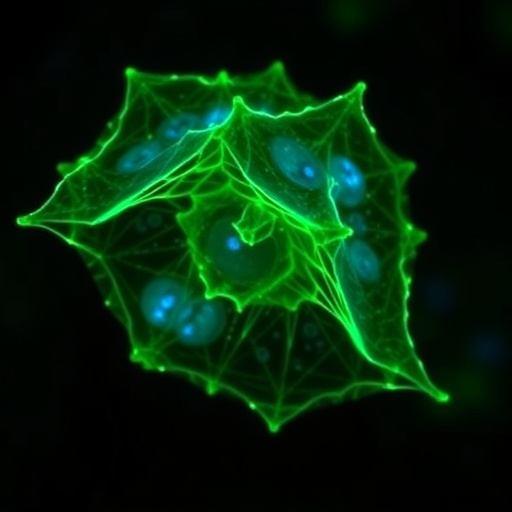
In a groundbreaking advancement in ovarian cancer therapeutics, researchers have unveiled a pioneering gene immunotherapy approach leveraging adeno-associated virus (AAV) vectors combined with CRISPR/Cas9 genome editing technology to directly target and disrupt PD-L1 expression within tumor cells. This innovative strategy addresses the persistent challenges faced by conventional antibody therapies aimed at immune checkpoint molecules, which have historically exhibited limited response rates in combating ovarian malignancies.
Ovarian cancer poses significant therapeutic hurdles due to its immunosuppressive tumor microenvironment, which often undermines the efficacy of immune checkpoint inhibitors. The protein programmed death ligand 1 (PD-L1), frequently overexpressed on ovarian tumor cells, plays a pivotal role in facilitating immune escape by interacting with PD-1 receptors on T cells, leading to their functional exhaustion. By precisely ablating PD-L1 at the genomic level, the new therapy strives to reinvigorate anti-tumor immune responses, offering a transformative route beyond conventional antibody blockade.
The research team engineered an AAV vector system capable of delivering CRISPR/Cas9 components specifically designed to target and knockout the PD-L1 gene in ovarian cancer cells. The choice of AAV as a delivery platform is strategic, given its well-characterized safety profile, low immunogenicity, and efficient transduction capabilities in vivo. Importantly, this viral vector-mediated gene editing approach circumvents the transient nature and systemic toxicity limitations commonly associated with antibody administration.
In vitro experimentation involved generating PD-L1-targeted AAV particles and subsequently transducing them into the murine ovarian cancer cell line ID8. Post-treatment analyses revealed a marked and statistically significant suppression of PD-L1 expression at the cellular level when compared against control groups treated with non-targeting AAV vectors. This clear demonstration of effective gene knockout established a foundational proof-of-concept for the therapeutic potential of the strategy.
Moving beyond cell culture, the study employed a peritoneal dissemination model of ovarian cancer, which closely mimics the clinical presentation of metastatic disease within the peritoneal cavity. Mice receiving intraperitoneal injections of PD-L1-targeting AAV particles exhibited significantly prolonged survival relative to control-treated counterparts. This survival benefit underscored the functional impact of PD-L1 gene disruption on tumor progression and host immunity in a living organism.
Crucially, immunohistochemical analyses shed light on the immunological dynamics within the tumor microenvironment following gene editing intervention. A pronounced increase in intratumoral CD4+ helper T cells and CD8+ cytotoxic T lymphocytes was observed in treated mice, a pattern consistent with reactivation of anti-tumor immune responses. Conversely, levels of Foxp3+ regulatory T cells, which typically suppress immune activity, were notably decreased, suggesting an immunological shift favoring tumor eradication.
The safety profile of this gene-editing approach was rigorously assessed by histological examination of major normal organs including lungs, spleen, liver, and kidneys. Absence of severe adverse effects or off-target tissue damage was confirmed, bolstering confidence in the translational viability of AAV-CRISPR-based ovarian cancer immunotherapy. The targeted nature of the therapy minimizes collateral damage and systemic toxicity, one of the chronic limitations inherent to conventional chemotherapy and antibody treatments.
This study highlights the immense promise of coupling genome editing technologies with viral delivery systems to overcome intrinsic immunotherapeutic resistance in ovarian cancer. By leveraging the precision of CRISPR/Cas9 to permanently disable immune checkpoint molecules like PD-L1, researchers can effectively dismantle the tumor’s immune suppressive shield and galvanize endogenous immune cells to attack malignant cells more robustly.
Moreover, the utilization of AAV vectors offers scalable and clinically relevant delivery that could be adapted for human patients. Given that AAVs have been extensively studied in gene therapy trials, their repurposing for cancer immunotherapy represents a logical extension of existing vector technologies. The relative stability and long-term expression facilitated by AAVs align well with the sustained anti-tumor immune activation required for durable remission.
An additional advantage of this approach is the potential to reduce the need for repetitive antibody dosing, thereby diminishing treatment burden, infusion-related adverse events, and economic costs associated with current immunotherapeutic regimens. By delivering a one-time gene-editing treatment that exerts persistent suppression of PD-L1 expression, patient outcomes and quality of life could see substantive improvement.
The increase in effector T cell infiltration combined with reduced immunosuppressive Treg populations further indicates a reprogramming of the tumor milieu towards heightened immunogenicity. This shift may sensitize tumors to additional therapeutic modalities, including vaccines or small molecule immune modulators, creating avenues for combination therapies that maximize anti-cancer efficacy.
Looking forward, it will be essential to evaluate the long-term genomic stability, off-target effects, and immune paradoxes associated with CRISPR/Cas9-based editing in clinical settings. Nevertheless, the current results provide a compelling foundation for transitioning this strategy into translational and clinical research pipelines aimed at tackling refractory ovarian cancer cases.
In the broader context of cancer immunotherapy, this study exemplifies a paradigm shift where targeted genetic disruption of immune inhibitory pathways can be precisely orchestrated in vivo, circumventing many pitfalls characteristic of protein-based inhibitors. Such technological convergence opens a frontier for tailored, patient-specific therapeutic innovations rooted in molecular medicine.
Ultimately, the integration of AAV delivery systems with CRISPR/Cas9-mediated genome editing could herald a new era in oncological treatments, where anti-tumor immunity is enhanced through bespoke genetic interventions rather than systemic pharmacologic blockade alone. This approach aligns well with the ongoing evolution of personalized medicine and the quest to achieve lasting cures in difficult-to-treat malignancies like ovarian cancer.
As clinical trials and further preclinical studies advance, the scientific and medical communities will keenly observe the progression of gene-based immune checkpoint modulation strategies. The potential for transforming ovarian cancer from a lethal disease into a manageable condition is closer than ever, driven by innovations that manipulate tumor-immune interactions at their genomic roots.
The findings also raise intriguing questions about expanding similar genome-editing immunotherapies to other solid tumors with high PD-L1 expression and inherent resistance to immune checkpoint inhibition. This platform technology could revolutionize therapeutic landscapes across multiple cancer types, shifting the paradigm from inhibition to eradication through engineered gene disruptions.
In summary, the AAV-CRISPR/Cas9-mediated knockout of PD-L1 represents a formidable leap forward in ovarian cancer treatment strategies. By elevating the immune system’s capacity to detect and attack tumors at a molecular level, this innovative gene immunotherapy holds tremendous potential to enhance survival outcomes and redefine the standards of care for patients worldwide.
Subject of Research: Ovarian cancer gene immunotherapy targeting PD-L1 using AAV-CRISPR/Cas9 genome editing
Article Title: Adeno-associated virus-clustered regularly interspaced short palindromic repeats/cas9‑mediated ovarian cancer treatment targeting PD-L1
Article References:
Yahata, T., Toujima, S., Sasaki, I. et al. Adeno-associated virus-clustered regularly interspaced short palindromic repeats/cas9‑mediated ovarian cancer treatment targeting PD-L1. BMC Cancer 25, 749 (2025). https://doi.org/10.1186/s12885-025-14093-0
Image Credits: Scienmag.com
DOI: https://doi.org/10.1186/s12885-025-14093-0
Tags: AAV gene therapy for ovarian canceradeno-associated virus delivery systemcancer immunotherapy advancementsCRISPR/Cas9 PD-L1 targetingenhancing anti-tumor immune responsegene editing in cancer treatmentimmune checkpoint inhibition in ovarian cancerinnovative treatments for resistant cancersnovel immunotherapy for ovarian malignanciesovercoming immunosuppressive tumor microenvironmentPD-L1 knockout strategyprecision medicine in oncology





